Used Ford Fiesta

The Ford Fiesta has been laid to rest but it’s going out on a high. This final generation of the long and loved line is a peach: great to drive, refined and practical.
It’s also a really good buy as a used car, which is handy because that’s more or less your only way to get one now.
There’s plenty of choice in the Fiesta range – not just in the sheer numbers on sale but also in the breadth of the model range. Take the engine line-up. The petrols include a 1.1-litre with 69bhp and 84bhp and a turbocharged 1.0-litre three-cylinder Ecoboost in 94bhp, 99bhp, 123bhp and 138bhp states of tune.
There’s also a 1.5-litre diesel with 84bhp or 118bhp, which was withdrawn from sale in 2020. Later models incorporate mild-hybrid technology in 1.0 Ecoboost 125 and 155 versions.
You can even have your seventh-generation Fiesta as a raised-up SUV called the Active, or as an impressively agile 197bhp ST hot hatch.
Trim choices are equally all-encompassing. Entry-level Style models have air-con and electric front windows, while Zetec adds 16in alloy wheels and a heated windscreen.
You also get an 8.0in touchscreen infotainment system, with Apple CarPlay and Android Auto, with Zetec and above. Titanium brings cruise control, automatic lights and wipers, and climate control, while B&O Titanium (there’s also a B&O Zetec) has an upgraded 10-speaker 675W sound system.
Titanium X gets the B&O sound system as standard along with heated front seats. ST-Line and ST-Line X gain sportier exterior and interior styling and firmer suspension.
ST-Line otherwise has the same equipment as Zetec, while ST-Line X is based on Titanium. Top-of-the-range Vignale has leather seats, a panoramic glass roof, rear parking sensors and a reversing camera.
But it’s the way it drives that sets the Fiesta apart. The 1.1 petrols and 1.5 diesels are pleasant enough but the 1.0 Ecoboost is the star. It’s punchy and refined and beguiling in any of its power outputs.
Few superminis are more enjoyable to chuck around on a twisty B-road, too. The steering is precise and well weighted, grip is plentiful and the car has good poise. To top it all off, the ride is beautifully judged, both in town and on motorways, even with the firmer ST-Line models.
Suspension noise is well suppressed too, giving the Fiesta a sense of solidity and big-car refinement.
Inside, the areas you touch frequently all feel fairly upmarket and the Fiesta uses soft-touch material on parts of its dashboard, although overall it doesn’t feel quite as solidly screwed together as the Seat Ibiza or Volkswagen Polo.
Still, it has plenty of room up front and a widely adjustable driving position. Two people of average height will be comfortable in the rear, but three in the back is more of an option for shorter journeys. Most models have a backrest that folds with a 60/40 split and the reasonably sized boot is relatively easy to access.
Which is the best Ford Fiesta?
Titanium: Two reasons for picking this trim. One, it comes with goodies such as ambient interior lighting, rear parking sensors, an automatically dimming rear-view mirror and a built-in sat-nav. And two, it’s good value.
1.0 100 Ecoboost: Our favourite is the three-cylinder 999cc engine, and of the four versions on offer we would go for the 99bhp version because it’s fast enough at motorway speeds and is also pretty economical.
We elected to test the Ford Fiesta in Active form, driven by Ford’s hybridised 1.0-litre Ecoboost engine and its seven-speed dual-clutch automatic gearbox, to find out whether a dose of SUV DNA has had a positive influence on this popular small car.
By John Evans
]]>

 Yahoo Autos
Yahoo Autos 